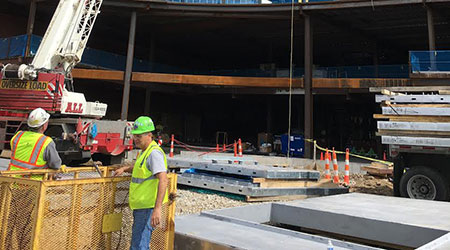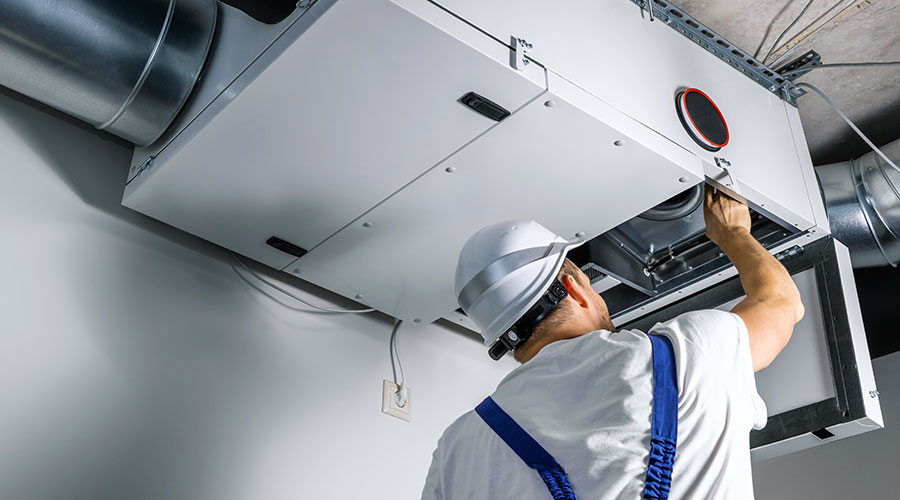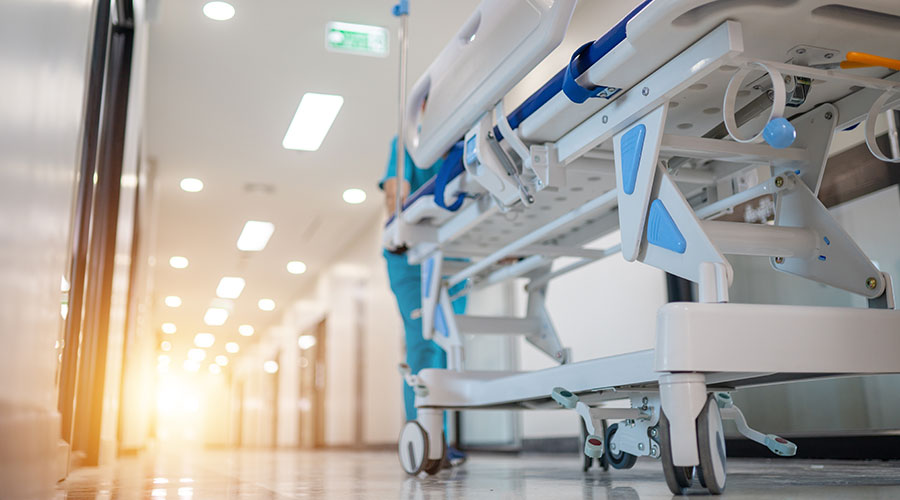Construction jobsites have evolved over the years. Tools that were once ideal may now be out of date. For example, the first hammer ever made was a sturdy stick with a rock tied to the end. As the years passed, the hammer transformed into what we know today. Construction techniques have also evolved, dramatically impacting workflow and project profitability. Companies that embrace new methods and challenge traditional theories stand out as successful partners for project owners.
Welty Building Company understands the value of embracing new methods, and have experienced success from taking an innovative approach to large and challenging projects. One of their most recent successes involved implementing Integrated Project Delivery (IPD) to foster teamwork and reduce project costs on the Akron Children’s Hospital Considine addition.
Their approach to challenging traditional methods extends far beyond a quick solution to a single project. Their team consistently focuses on implementing smart, efficient and sustainable choices. They refer to this corporate philosophy as ‘Thinking Welty’ and they implement that mentality in every project decision. Welty’s process involves planning, evaluating and constantly reevaluating each day to make sure products stay on track and on budget. This strategic and focused approach lead to a 38-day-early finish and $27 million saved on the Akron Children’s Hospital Considine project.
Designed to provide a better patient, family and employee experience, the 7-story, 230,000-square-foot medical office building nearly doubles the size of the current Akron Children’s Hospital. It incorporates many enhanced features - such as a new café and state-of-the-art registration area – and is connected to the main hospital by a safe pedestrian bridge.
A team approach – The buy In
Welty’s relationship with Akron Children’s Hospital began long before the most recent addition, and their focused and strategic approach has led to a loyal partnership. Most recently, Welty partnered with Akron Children’s Hospital on the Kay Jewelers Pavilion, which opened in 2015. That project transformed Welty’s work process by introducing their team to IPD, a strategy that looks beyond sustainability and lean construction techniques. Tom Conti, Senior Superintendent at Welty, calls IPD a game-changing approach. IPD makes all partners – owners, contractors and trade partners – stakeholders in the project. Affected by the project outcome, each stakeholder earns a profit from the wins and shares in the cost of failures. When implemented, the IPD process tends to drive down costs and foster teamwork and cooperation while speeding up each phase of the project. Akron Children’s Kay Jewelers Pavilion was Ohio’s first IPD project and it resulted in a $40 million reduction in cost and completion date two months ahead of schedule.
“It’s a win together teamwork mentality,” Conti said. “In IPD, everyone from the architect to the trade partners recognizes that working for one common goal will result in a successful project, and more importantly, a happy customer.”
Due to the success of the Kay Jewelers Pavilion and the original Considine building, Akron Children’s called on Welty when the plans for the Considine addition began to take shape in 2016. Once again, the project owner wanted to implement the successful IPD process.
The process incorporated an initial planning session, including the architect, engineers, contractors and trade partners. The session pooled everyone’s ideas and expertise to design the project and develop a plan for successful completion. The design was based on the specified needs of the hospital, including the square footage and any specific design requirements. The meetings continued every few weeks and more frequently as the ground-breaking approached. Initial project estimates totaled more than $100 million, but one of the benefits of the IPD approach is its ability to generate substantial cost savings in large-scale, multi-million dollar projects. The team reworked the plan, implemented new techniques and brought the project within budget at a cost of $84 million.
Conserve resources
One technique the team used to minimize costs was implementing a shared equipment program with a single rental center vendor. ALL Erection & Crane Rental Corp. provided all the equipment for the jobsite. Streamlining the equipment selection resulted in better utilization, economies of scale and no wasted space or idle equipment on the site. ALL Crane became a member of the weekly meetings and helped maximize resources and conserve funds. Each week the ALL Crane team worked with the different contractors on the job to define equipment needs and match the ideal product.
ALL Crane worked with their aerial division, ALL Aerials out of Richfield, Ohio, to provide boom and scissor lifts. Zac Kasparek, ALL Aerials sales manager, developed a strong relationship with Conti when they met during the Kay Jewelers Pavilion project.
When it came to lifts, Conti knew exactly what he needed — a compact, lightweight lift that was versatile enough to complete almost all the at-height jobs the project required.
“We completed the Children’s Hospital Kay Jewelers Pavilion with some Hy-Brid Lifts and discovered how compact and maneuverable they were,” Conti said. “I reached out to Zac and told him we needed Hy-Brid on this site.”
The Hy-Brid lifts offer a working platform up to 30-by-69.5-inches and low floor loading of 138 to 185 psf. The lower floor loading allows more equipment in any one area of the project, critical for the workflow approach Welty and their sub-contractors used on the Akron Children’s project.
“Tom came to me asking specifically for Hy-Brid compact scissor lifts,” Kasparek said. “The lifts offered the capacity for two workers but were still compact, lightweight and easy to operate. Since all the different trades would share the lift, Tom and I knew Hy-Brid offered the ultimate versatility.”
For the Considine project, ALL Aerials supplied 87 pieces of aerial equipment — 50 of which were Hy-Brid Lifts — including 10-, 12- and 14-foot lifts. Hy-Brid Lifts seamlessly transitioned across the trades and multitude of applications on the hospital project from HVAC, electrical and plumbing work to drywall and painting projects. And with platform heights between 10 and 14 feet and actual working heights of approximately 16-to-20 feet, the lifts were ideally sized for nearly any aspect of the project.
Conti said with the shared equipment approach and versatility of the compact lifts, his team was able to complete 90% of the at-height work on the project with Hy-Brid Lifts. There were a few areas like the mezzanine that required 19- and 26-foot lifts from other manufacturers. However, these taller lifts were assigned to specialized tasks that required the extra height so as not to impede the overall workflow.
Track progress
The lightweight lifts’ maneuverability and versatility were only secondary when compared to their overall impact on the project approach. Welty and the teams of contractors on site implemented a last planner system that incorporated a series of sticky note tasks on a board to build a solid plan for completion. The note’s task represented a “reliable commitment” for completion by that contractor. Tasks were planned out on the board for six weeks’ worth of work. At each morning huddle, contractors came to the board and placed their note to confirm their crew’s plan for the day.
The team then implemented takt based scheduling, dividing the building into zones by floor called takt areas. To maximize efficiency, each takt area was assigned to a single contractor at a time — with only their tools, crew and equipment operating in that zone. The daily work completion commitment meant each crew would complete their work in that zone that day and have it broom swept, clean and ready for the next group. And because IPD is an “all win or all lose” approach, if problems did occur, contractors would work together to address the issues and keep the project flowing.
“The teamwork between crews could be seen throughout the jobsite,” Conti said. “During weekly meetings you’d hear one group say, ‘we’ll help out here to get us back on schedule.’ That’s what I really enjoy about IPD, seeing partners unite.”
Takt areas allowed simultaneous work in multiple areas of a project, keeping contractors from tripping over each other and the overall progress moving forward. The takt approach was supplemented by a commitment to prefabricate any possible components in order to speed up the project.
Working safely
Crews used sections of an adjacent warehouse to prefabricate ceiling and corridor sections, having them ready for installation at the appropriate time. This not only added speed to the overall project, but also enhanced worksite safety. Prefab work was done at waist height, allowing workers added comfort and increased safety – something important to Conti and the Welty team.
“Every big construction project we work on has a full-time safety staff on site each day and safety is a key topic at each morning discussion,” Conti said. “The safety team is constantly looking for ways to improve comfort and safety on the job and educating the team on steps they can take to increase safety. Safety isn’t a word for us. It’s a way of life.”
Welty jobsites follow a ladders last approach, always recommending a scissor lift when possible. For increased safety, a permit is required for any ladder over 6 feet. Welty representatives review each situation and, in most cases, determine that a compact scissor lift is a safer alternative.
At each morning meeting, the crew discussed issues that happened the previous day and solutions for resolving those issues. By reflecting on each situation, Conti says teams learned how to identify safety hazards and recognize a safer alternative. According to Welty, the Children’s Hospital Considine addition earned a safety rating 40% better than the national average.
Bring it all together
Construction of the Considine building was completed in August 2018 and crews moved on to additional updates in the existing hospital. The original building was converted to an outpatient facility for same-day care and procedures. Work between the two buildings is seamless and blends together from one building to the other. Crews finished with the updates in February 2019.
Despite a few bumps in the timeline due to weather and other uncontrollable events, the project was complete ahead of schedule thanks to IPD. When Conti looks back at the project, he chalks its success up to one thing — strategic planning. Carefully considering the project, proper tools and best methods for success, he says, has led to a win time and again.
Conti often reminds his team and partners about the importance of planning; on the wall of his huddle room he has a poster tacked up with a quote from Winston Churchill. “Failing to plan is planning to fail.”

 Deferred Maintenance: 5 Critical Issues
Deferred Maintenance: 5 Critical Issues AdventHealth Parker Breaks Ground on $300 Million Expansion Project
AdventHealth Parker Breaks Ground on $300 Million Expansion Project HHS Proposes Changes to HIPAA Security Rule to Enhance Cybersecurity
HHS Proposes Changes to HIPAA Security Rule to Enhance Cybersecurity Navigating the Healthcare Real Estate Landscape in 2025
Navigating the Healthcare Real Estate Landscape in 2025 UI Health Care Acquires 20 Mission Cancer + Blood Clinics in Iowa
UI Health Care Acquires 20 Mission Cancer + Blood Clinics in Iowa